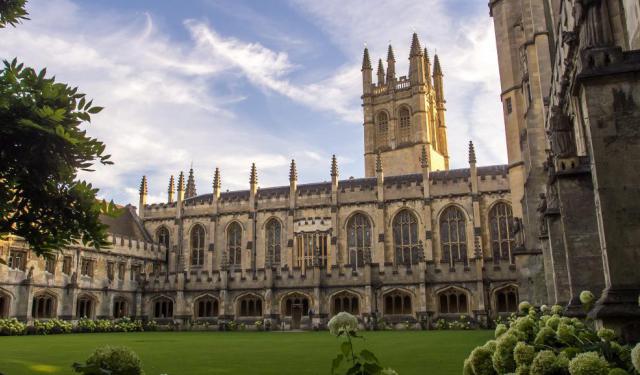
Oxford University Press, Oxford
The Oxford University Press (OUP) building is located at the intersection of Great Clarendon Street and Walton Street in the Jericho district of the city. If you're interested in visiting the OUP Museum, you can do so by scheduling an appointment.
OUP holds the distinction of being the largest university press in the world, with offices scattered across various locations worldwide. The origins of this institution trace back to the year 1480, just two years after Theodoric Rood brought his wooden printing press from Cologne and established it in the city. The first book produced using this press was a copy of "Exposito in symbolum apostolorum" by Rufinus.
Over time, the University became increasingly involved in the printing of Bibles and other theological and educational texts. In 1633, OUP's legal standing was formalized through the Great Charter obtained by Archbishop William Laud from King Charles I. This charter granted the university the authority to publish books beyond the theological realm.
In 1713, the Clarendon Building on Broad Street was erected specifically to accommodate OUP, serving as its headquarters until 1825. The present-day OUP building was constructed by Edward Blore and Daniel Robertson.
Notably, OUP played a pivotal role in editing and printing the first Oxford English Dictionary during the 19th century. In 1834, the press acquired its own paper mill, expanding its operations and establishing offices in both America and India.
For more than a century, OUP has been responsible for printing books across a wide spectrum of subjects, encompassing everything from children's stories to World Classics.
OUP holds the distinction of being the largest university press in the world, with offices scattered across various locations worldwide. The origins of this institution trace back to the year 1480, just two years after Theodoric Rood brought his wooden printing press from Cologne and established it in the city. The first book produced using this press was a copy of "Exposito in symbolum apostolorum" by Rufinus.
Over time, the University became increasingly involved in the printing of Bibles and other theological and educational texts. In 1633, OUP's legal standing was formalized through the Great Charter obtained by Archbishop William Laud from King Charles I. This charter granted the university the authority to publish books beyond the theological realm.
In 1713, the Clarendon Building on Broad Street was erected specifically to accommodate OUP, serving as its headquarters until 1825. The present-day OUP building was constructed by Edward Blore and Daniel Robertson.
Notably, OUP played a pivotal role in editing and printing the first Oxford English Dictionary during the 19th century. In 1834, the press acquired its own paper mill, expanding its operations and establishing offices in both America and India.
For more than a century, OUP has been responsible for printing books across a wide spectrum of subjects, encompassing everything from children's stories to World Classics.
Want to visit this sight? Check out these Self-Guided Walking Tours in Oxford. Alternatively, you can download the mobile app "GPSmyCity: Walks in 1K+ Cities" from Apple App Store or Google Play Store. The app turns your mobile device to a personal tour guide and it works offline, so no data plan is needed when traveling abroad.
Oxford University Press on Map






Sight Name: Oxford University Press
Sight Location: Oxford, England (See walking tours in Oxford)
Sight Type: Attraction/Landmark
Sight Location: Oxford, England (See walking tours in Oxford)
Sight Type: Attraction/Landmark
Walking Tours in Oxford, England
Create Your Own Walk in Oxford
Creating your own self-guided walk in Oxford is easy and fun. Choose the city attractions that you want to see and a walk route map will be created just for you. You can even set your hotel as the start point of the walk.
Harry Potter Walk in Oxford
In addition to its conventional university fame, more recently Oxford has emerged as a major filming location for the magical world of Harry Potter.
The picturesque New College served as the backdrop for several scenes in the Harry Potter movies. Its cloisters were used as the setting for Hogwarts' interiors, where characters like Harry Potter, Hermione Granger, and Ron Weasley walked... view more
Tour Duration: 1 Hour(s)
Travel Distance: 1.0 Km or 0.6 Miles
The picturesque New College served as the backdrop for several scenes in the Harry Potter movies. Its cloisters were used as the setting for Hogwarts' interiors, where characters like Harry Potter, Hermione Granger, and Ron Weasley walked... view more
Tour Duration: 1 Hour(s)
Travel Distance: 1.0 Km or 0.6 Miles
Oxford Introduction Walking Tour
Oxford, a city in central England, has captivated the minds of scholars and travelers for centuries. The name "Oxford" originates from the Old English "Oxenaford," which means "shallow crossing of the oxen." It harks back to the early days (circa 900 AD) when a small settlement established by the Anglo-Saxons served as an important crossing point on the upper reaches... view more
Tour Duration: 2 Hour(s)
Travel Distance: 3.5 Km or 2.2 Miles
Tour Duration: 2 Hour(s)
Travel Distance: 3.5 Km or 2.2 Miles
Colleges of Oxford University
The University of Oxford is the oldest educational institution in England and one of the best in the world. Alma mater for thousands of the most influential people on the planet, it is also a major attraction for architecture and history buffs.
The university represents a "federation" incorporating 38 self-governing colleges and six permanent private halls. Let's take a closer... view more
Tour Duration: 1 Hour(s)
Travel Distance: 1.5 Km or 0.9 Miles
The university represents a "federation" incorporating 38 self-governing colleges and six permanent private halls. Let's take a closer... view more
Tour Duration: 1 Hour(s)
Travel Distance: 1.5 Km or 0.9 Miles



